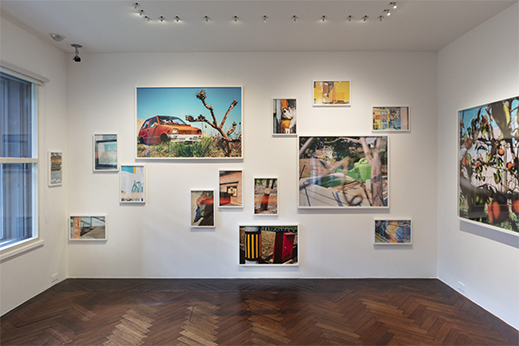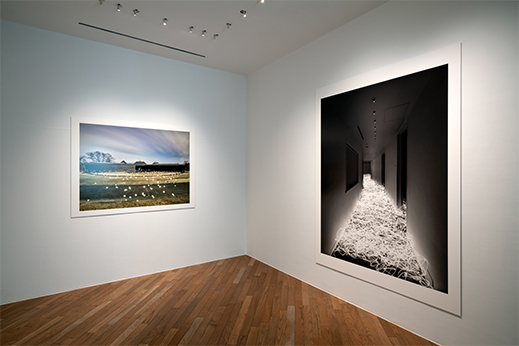 |
|
Here and There introduces art, artists, galleries, museums, and other cultural facilities around Japan that non-Japanese readers and first-time visitors may find of particular interest.
|
|
 |
|
|
 |
 |
End of an Era: The Hara Museum's Last Show
Alan Gleason |
 |
The main entrance of the Hara Museum in Shinagawa, Tokyo. |
Tokyo's art scene will suffer a great loss when one of its mainstays, the Hara Museum of Contemporary Art, closes its doors in mid-January. When it opened in 1979, the Hara was the first museum in the capital, and one of the first in the nation, to focus on contemporary art. Since then it has presented a roster of consistently top-notch artists from Japan and overseas. But what makes a visit to the Hara such a unique experience is the venue itself, a classic example of prewar Art Moderne architecture that was originally a private residence, built by the Hara family in 1938. Looking out over a spacious garden on a Tokyo hilltop and filled with intimate spaces and quirky design elements in a handsome crescent-shaped layout, it is a museum like no other. We will miss it badly.
The courtyard garden of the Hara Museum, with its café in the background. Photo by Osamu Watanabe |
The good news is that the Hara's collection already has a new home waiting for it: Hara Museum ARC in Shibukawa, Gunma Prefecture, a much larger structure of striking design (by Arata Isozaki) that opened in 1988 as an annex to the Tokyo facility. With the original Hara showing its age, and the cost of upgrading and reinforcement prohibitive, the move makes perfect sense. Besides, the Gunma museum boasts its own attractive ambience in a bucolic setting at the foot of Mt. Haruna, only an hour and a half northwest of Tokyo by Shinkansen. (Note: Hara Museum ARC will be closed for renovations through March 2021.)
And yet . . . the old Hara really is one of a kind, and irreplaceable. No wonder that fans are beating a path there, pandemic be damned, to catch its final exhibition, Time Flows: Reflections by 5 Artists, on view until the doors shut for good on 11 January 2021. For purposes of crowd control as well as health-risk reduction, the museum is wisely accepting visitors in relatively small numbers per hour, by reservation only.
 |
|
Installation view, Time Flows: Reflections by 5 Artists, with Masaharu Sato's Tokyo Trace (2015-2016) on video monitors at left and right, and Tamotsu Kido's photographs on the walls to the rear. |
As the title suggests, the works gathered here all trace changes of one sort or another over time. Yet they are just as much about light as they are about time, an aspect foregrounded in the Japanese title -- Hikari - Kokyu, literally "Light - Breath" -- if not the English one. For one thing, all five artists work with light-processing technologies: photography, video, projection. Interestingly, however, nearly all of them started out painting or sculpting before finding their forte in these other media.
The painterly eye is most evident in the photographs of Tamotsu Kido, whose bright, sunny, saturated color shots of the detritus of modern civilization cover three walls at one end of the Hara's long, curving ground-floor gallery. Kido delights in odd couplings he encounters on drives through rural Japan -- an abandoned car and a dead tree sharing a vacant lot, say -- or that occur due to double exposures and other photo-processing "accidents."
 |
|
Installation view of Tamotsu Kido's photographs. Photo by Tamotsu Kido |
Sharing the same room with Kido and continuing in the hallway outside is an array of monitors showing Masaharu Sato's Tokyo Trace series of videos. They depict everyday scenes in the capital, but with an eerie twist: in every sequence, a central motif has been hand-traced and animated by the artist. Thus people, cars and buses pass by a hand-drawn National Diet Building; an animated swing sways back and forth, metronome-like, in a deserted playground; and a vase of flowers sits in a stark institutional setting of tabletop and curtain, ostensibly a still life yet shimmering with an ineffable life-force. This last image takes on added poignance when one learns that the artist died in his forties from cancer a year ago, and that his wife had brought him the flowers while he was hospitalized in the midst of creating this series.
Masaharu Sato, Tokyo Trace (2015-2016), one channel of a 12-channel video. © Masaharu Sato |
The passage of time is most explicitly addressed in Tomoki Imai's photo project Semicircle Law. The title refers to the arbitrary compass-drawn "no-go" zone around the Fukushima Daiichi Nuclear Power Plant after its March 2011 meltdown. Imai shot these photos from the tops of mountains within a 30-kilometer radius of the plant, always pointing his camera in its direction whether or not it was visible. For the current show he took similarly aimed shots from the roof of the museum. Imai's concern, he says, is with the "remorselessness of time towards memory," and the use of photography as a "small act of resistance" against the forces that make us forget.
Installation view of part of Tomoki Imai's Semicircle Law (2012-2020) series. In the foreground are a map and compass indicating the direction of the Fukushima Daiichi Nuclear Power Plant. Photo by Tomoki Imai |
The most enigmatic of these installations is Flowers by Hong Kong-born, Taiwan-based Lee Kit, the only non-Japanese artist featured here. Lee's work is difficult to grasp precisely because it consists largely of the play of light, both natural and projected, across a single room. A dim projection onto a large window creates an intermingling of shadows with the greenery outside, while light shining on another wall illuminates a small drawing of a woman's head in profile. The effect is so hard to pin down that, in its very elusiveness, it perfectly captures the evanescent qualities of both light and time.
Lee Kit, Flowers (2018); acrylic, emulsion paint, inkjet ink and pencil on cardboard, projector light. © Lee Kit, photo by Shigeru Muto |
However, it is the contribution of Tokihiro Sato that stands out in this show, not least because his subject matter is the Hara Museum itself. Sato is known for his use of long exposures to create mystical landscapes suffused with patterns of white light, which he produces by moving through the scene with a penlight by night or a sun-reflecting mirror by day (his rapid movements render his own figure invisible). For this installation Sato took his penlight on a tour of the Hara, literally highlighting the beauty of the building's curving hallways and stairwells. The pristine resolution and high contrast of the large monochrome prints also bring out the patina of age on the outer walls of the building, a telling reminder of its impending closure.
Tokihiro Sato, Photo-Respiration Harabi#1 (2020), pigment print. © Tokihiro Sato |
So critical is the presence of Sato's work here that the exhibition's Japanese title is actually taken from the name of his series: Hikari - Kokyu, which he translates as Photo - Respiration. In many ways it is the glue that holds this assemblage of rather disparate works together. As curator Masami Tsubouchi notes in her essay in the exhibition catalog (bilingual, with excellent English translation by Norman Chan), "the Hara Museum's unique spatial characteristics were always more apparent in solo rather than group exhibitions, but my interest in mounting this group show was to somehow reflect within it the discord and dissonance [. . .] that take place within the larger society." To this end the installations of the five artists are intentionally arranged to share the Hara's rather cozy gallery spaces, rather than each getting a room of its own. This layout does yield some interesting juxtapositions, though it is sometimes hard to figure out whose work is whose.
 |
|
Installation view of Tokihiro Sato's Photo-Respiration HaraArc#1 (2020), taken at Hara Museum ARC (left), and Photo-Respiration Harabi#9 (2020) (right). Photo by Tomoki Imai |
Tsubouchi closes her essay expressing the hope that "such an exhibition might provide an opportunity for the viewer to hold back time that would ordinarily flow by unnoticed" and "to preserve scenes that threaten to disappear unheeded." The cloistered, bygone-era ambience of the Hara does indeed coax the visitor out of the fraught world of 2020 for a few precious hours unstuck in time. But Tsubouchi's words also remind us that this wonderful edifice is itself on the verge of disappearing from our lives, and there is no way to hang on to it.
Artscape Japan has covered exhibitions at the Hara several times over the years. You can read past Focus reviews with more details about the museum's architecture here and its history here.
Nobuo Sekine, Phase in the Sky (1980), white granite and stainless steel; one of several outdoor sculptures gracing the gardens of the Hara Museum. Photo by Alan Gleason |
All photos are courtesy of or by permission of the Hara Museum of Contemporary Art. |
 |
| Time Flows: Reflections by 5 Artists |
| 19 September 2020 - 11 January 2021 |
| Hara Museum of Contemporary Art |
4-7-25 Kita-Shinagawa, Shinagawa-ku, Tokyo
Phone: 03-3445-0651
Hours: 11 a.m. to 4 p.m. weekdays, to 5 p.m. weekends and national holidays; closed Mondays (except 11 January) and during the New Year holiday (28 December - 4 January)
*Advance reservations required*
Access: 5 minutes by taxi or 15 minutes on foot from the Takanawa Exit of JR Shinagawa Station on the Yamanote, Keihin-Tohoku and Tokaido Lines
|
|
|
|
| |
 |
Alan Gleason
Alan Gleason is a translator, editor and writer based in Tokyo, where he has lived for over 30 years. Since 2006 he has edited artscape Japan and written the Here and There column, as well as translating the Picks reviews. He also edits and translates works on Japanese architecture, music, and theater. |
|
|
|
|
|
|
|
|
|
 |
|